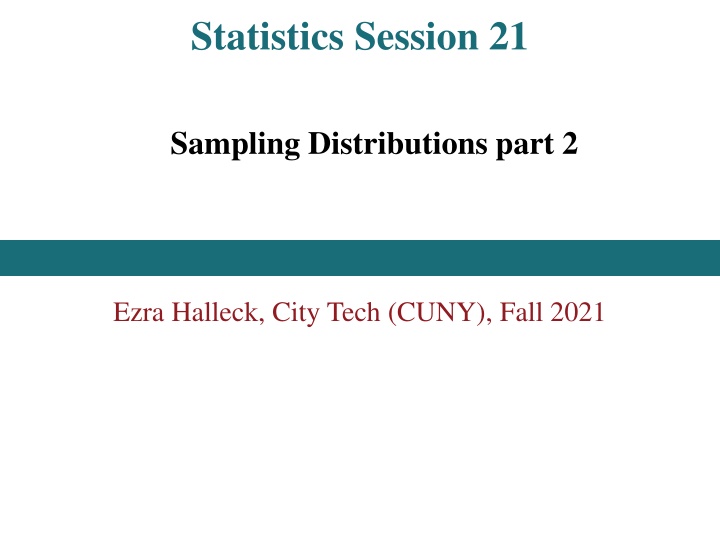
Sampling Distributions and Errors in Opinion Polls
Explore the importance of sound sampling methods in opinion polls to minimize errors. Learn about sampling distributions, mean, standard deviation, and the impact of sample size on accuracy. Discover key observations and considerations in sampling from non-normally distributed populations.
Download Presentation

Please find below an Image/Link to download the presentation.
The content on the website is provided AS IS for your information and personal use only. It may not be sold, licensed, or shared on other websites without obtaining consent from the author. If you encounter any issues during the download, it is possible that the publisher has removed the file from their server.
You are allowed to download the files provided on this website for personal or commercial use, subject to the condition that they are used lawfully. All files are the property of their respective owners.
The content on the website is provided AS IS for your information and personal use only. It may not be sold, licensed, or shared on other websites without obtaining consent from the author.
E N D
Presentation Transcript
Statistics Session 21 Sampling Distributions part 2 Ezra Halleck, City Tech (CUNY), Fall 2021
Opening Example You read about opinion polls in newspapers, magazines, and on the Web every day. These polls are based on sample surveys. Have you heard of sampling and nonsampling errors? It is good to be aware of such errors while reading these opinion poll results. Sound sampling methods are essential for opinion poll results to be valid and to minimize effects of such errors. 2
7.2 REVIEW Mean and Standard Deviation of x bar The mean and standard deviation of the sampling distribution of x are called the mean and standard deviation of x and are denoted by and , x x respectively. The mean of the sampling distribution of x is always equal to the mean of the population. Thus, x= 3
Standard error: Standard Deviation of ? The standard deviation of the sampling distribution of ? is ? ? ?= ? Where: Sample size can be no more than 5% of population, i.e., ? ? is the standard deviation of the population; n is the sample size. 1 20= 0.05 ? ? ? 1, .i.e., ? ?= ? ? ? ? 1 If proportion is >5%, use correction factor ? ? ? is known as the Standard Error. 4
Two Important Observations 1. The spread of the sampling distribution of ? is smaller than the spread of the corresponding population ?, i.e. ? ?< ? 2. The standard deviation of the sampling distribution of ? decreases as the sample size increases. 5
7.3 Review Sampling from a Population That Is Not Normally Distributed According to the central limit theorem, for a large sample size, the sampling distribution ? is approximately normal, irrespective of the shape of the population distribution. The mean & standard deviation of the sampling distribution ? are as we have already stated: = = and x x n The sample size is usually considered to be large if ? 30, another rule of thumb . 6
Population Distribution and Sampling Distributions of x bar for nonnormal X Population distribution Sampling Distribution ? = 30 Sampling Distribution ? = 4 Sampling Distribution ? = 80 Sampling Distribution ? = 15 The vertical lines in the left graphs are used to indicate ? ? and ? ?+ ? ?. Note skewing. 7
7.4 Applications of the Sampling Distribution of ? Reminder of empirical rule: 1. Take all possible samples of the same (large) size from a population and calculate the mean for each of the samples: ~ 68% of the sample means will be within one standard deviation of the population mean. 8
Reminder of empirical rule (cont) 2. Take all possible samples of the same (large) size from a population and calculate the mean for each of the samples: ~ 95% of the sample means will be within two standard deviations of the population mean. 9
Reminder of empirical rule (cont) 3. Take all possible samples of the same (large) size from a population and calculate the mean for each of the samples: ~ 99.7% of the sample means will be within three standard deviations of the population mean. 10
Rice bags example If the weights of bags of rice are normally distributed with a mean of 32 ounces and a standard deviation of 0.3 ounce, find the probability that the mean weight, ?, of a random sample of 20 bags will be between 31.8 and 31.9 ounces. Solution: begin by verifying that assumptions for using the CLT have been satisfied: Since the population from which the sample is taken is normal, the minimal sample size of 30 does not apply. So, the answer is yes! Here are the sample dist parameters: .3 20 x= = = 0.6708204 ounce x= 32 ounces = n 11
Rice bags solution (cont) Now find the z values for the interval endpoints using: = 31 8: . For x 31 8 32 06708204 . . = = 2 98 . z = 31 9: x . For 31 9 32 06708204 . . = = 1 49 . z For a sandwich inequality, we find the area up to the right endpoint and subtract the area up to the left endpoint: ( ) ( ( ) = = = 2 98 . 31 8 31 9 1 49 . P . x . P P z z ) ( ) 1 49 0014 . 2 98 . . P z = .0667 0681 . Excel work is presented on next slide. 12
Rice bags Excel work and picture mu sigma n std err P(31.8<Xbar<31.9) 0.0666 =NORM.S.DIST(F4,TRUE)-NORM.S.DIST(E4,TRUE) 32 0.3 20 left 31.8 -2.9814 -1.49071 right 31.9 xbar z 0.06708204 13
Rice bags: TI84 work and Rguroo picture Note how this is very similar to what we have done earlier. 14
Costs to a bank for servicing checking accounts According to Moebs Services Inc., an individual checking account at major U.S. banks costs the bank on average $400 per year to service. Suppose the standard deviation is $30 and that a small branch has 225 such accounts. Let ? be its average cost to service these accounts. What is the probability that its average annual cost to service the accounts accounts is less than the population mean by $2.70 or more, i.e, $400 - $2.70? Solution: The shape of the probability distribution of the population is unknown. However, since the sample size 225 is sufficiently large (>30), we can apply the CLT: $400 = = 30 225 = = = $2 00 . x x n 15
Costs to bank for checking accounts solution (cont) 397 30 400 1 35 2 00 x . ( ) ( ) $397 50 1 35 P x . P z . = = Thus, chance that the average annual cost of the checking accounts in this sample is less than the population mean by $2.70 or more is .0885. x . Excel: NORM.S.DIST(-1.35,TRUE) z = = = . .0885 16






















